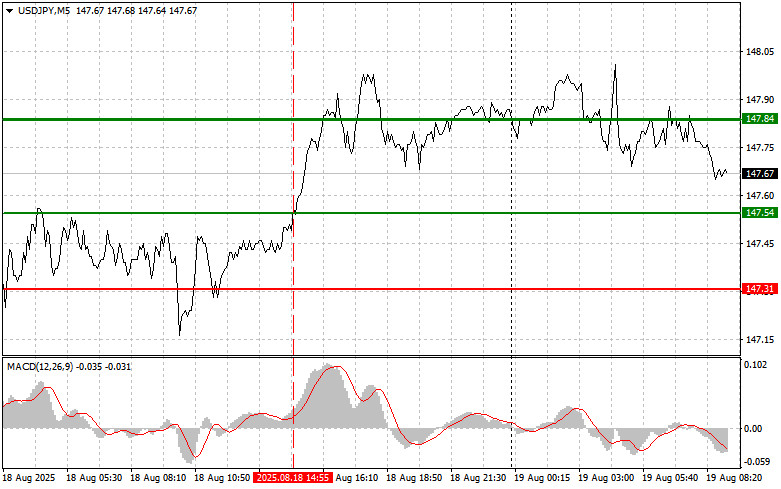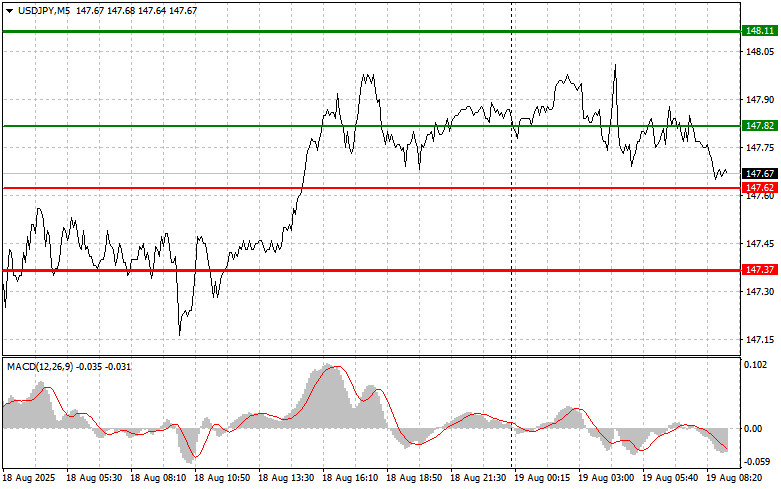Analysis of Trades and Trading Tips for the Japanese Yen
The price test of 147.54 occurred at a moment when the MACD indicator had already moved significantly upward from the zero mark, which, in my view, limited the pair's bullish potential. For this reason, I did not buy the dollar and missed a strong upward move in the pair.
However, as we can now see on the chart, after updating the weekly high, the dollar's growth did not continue. On the contrary, the pair corrected quite sharply, erasing most of yesterday's recovery. All this suggests that many traders are cautious ahead of new statements by Federal Reserve Chairman Jerome Powell, expected later this week. A shift in his stance toward interest rate cuts—something a considerable number of economists and investors anticipate—could undermine the bullish trend in USD/JPY. That said, the effect of such a decision would not be one-sided. Expectations of U.S. interest rate cuts would certainly weaken the dollar against the Japanese yen, creating favorable conditions for yen appreciation. At the same time, a stronger yen could negatively affect Japan's export-oriented economy. A more expensive yen reduces the competitiveness of Japanese goods on the global market, which could lead to a decline in export volumes and slower economic growth. In this context, the Bank of Japan may consider countermeasures aimed at curbing the strengthening of the national currency.
For intraday strategy, I will focus primarily on Scenarios #1 and #2.
Buy Scenario
Scenario #1: I plan to buy USD/JPY today when the entry point reaches around 147.82 (green line on the chart), targeting growth toward 148.11 (thicker green line on the chart). Around 148.11, I intend to exit the buy positions and open sell positions in the opposite direction (looking for a 30–35-point reversal from the level). It is best to return to buying the pair on corrections and significant pullbacks in USD/JPY. Important! Before buying, ensure the MACD indicator is above the zero mark and starting to rise from it.
Scenario #2: I also plan to buy USD/JPY today in the event of two consecutive tests of the 147.62 price level, specifically when the MACD indicator is in the oversold area. This would limit the pair's downside potential and lead to an upward reversal. Growth toward the opposite levels of 147.82 and 148.11 can be expected.
Sell Scenario
Scenario #1: I plan to sell USD/JPY today only after the price breaks below 147.62 (red line on the chart), which will lead to a quick decline in the pair. The key target for sellers will be 147.37, where I intend to exit sales and immediately open buys in the opposite direction (looking for a 20–25-point reversal from the level). Selling is best done from higher levels. Important! Before selling, ensure the MACD indicator is below the zero mark and is just beginning to decline from it.
Scenario #2: I also plan to sell USD/JPY today if the price level at 147.82 is tested consecutively, especially when the MACD indicator is in the overbought area. This would limit the pair's upward potential and lead to a reversal downward. A decline toward the opposite levels of 147.62 and 147.37 can be expected.
What's on the Chart:
- The thin green line represents the entry price where the trading instrument can be bought.
- The thick green line indicates the expected price level where a Take Profit order can be placed, or profits can be manually secured, as further price growth above this level is unlikely.
- The thin red line represents the entry price where the trading instrument can be sold.
- The thick red line indicates the expected price level where a Take Profit order can be placed, or profits can be manually secured, as further price decline below this level is unlikely.
- The MACD indicator should be used to assess overbought and oversold zones when entering the market.
Important Notes:
- Beginner Forex traders should exercise extreme caution when making market entry decisions. It is advisable to stay out of the market before the release of important fundamental reports to avoid exposure to sharp price fluctuations. If you choose to trade during news releases, always use stop-loss orders to minimize potential losses. Trading without stop-loss orders can quickly wipe out your entire deposit, especially if you neglect money management principles and trade with high volumes.
- Remember, successful trading requires a well-defined trading plan, similar to the one outlined above. Making impulsive trading decisions based on the current market situation is a losing strategy for intraday traders.













